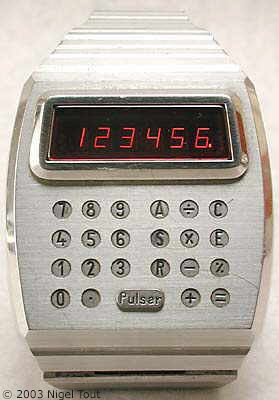

The Pulsar Calculator Watch


"For the man who had everything"
by Guy Ball
Original article from The International Calculator Collector.
By the mid 1970s, portable electronic calculators were firmly entrenched in the hands of the modern consumer. Prices had dropped to the point where virtually every household had one. But that also meant that manufacturers who had grown from the high profits of the first series of calculators, were hurting from the razor-thin margins of the now "everyday" product.
Electronic wristwatches using micro-circuitry and red LED displays were becoming the next consumer frontier. "What about combining a calculator with that watch?" some savvy executives thought. "Would those now-elusive large profits return in this limited production new product?" Leading the pack in that thinking was one of the few "old-timer" watch companies that saw great potential in the combining of electronics and watches.
Pulsar was the brand name of The Time Computer company of Lancaster, Pennsylvania (USA), formerly the Hamilton Watch Company. Their first LED time-only watches (the P1 series) were sold as early as 1971-72. Their corporate advertising slogan was "the Time Computer, no larger than a wristwatch. First completely new way to tell time in 500 years." They also liked to say "the man who has everything won't be happy until he has Pulsar."
IACC member Tom Welch recounts a humorous story he found in his research. "The prototype Pulsar watches were unveiled at a press conference on May 6th 1970. The story is they only had three working models at the time, and they only worked for a short time. So they kept rotating the three behind a curtain so the press would always see a working model."
Once the production glitches were resolved, the various Pulsar models were extremely high-quality timepieces sold mainly at the best jewelry stores. Even their stainless steel versions cost almost $300 (in 1970's dollars). In late 1975, Pulsar came out with their first red LED calculator watch. It was a solid 18K. gold model (#1822) that sold for $3950. The first ads were from Tiffany's (of course) in New York City and ran just in time for Christmas. (And all I got that year was a sweater and some new jeans, darn!)
Included with the watch was a classy, two-headed pen with one end serving as a stylus to work the calculator's tiny keys. The red-colored crystal over the LED display, a "time screen," was made of a synthetic sapphire that the manufacturer said would scratch a concrete sidewalk before the concrete would scratch the crystal.
The arithmetic functions included addition, subtraction, multiplication, and division. The watch also had memory, floating decimal, and percent functions. The calculator had a six-digit display with 12-digit calculating capability.
The time functions included a highly intelligent date feature that automatically adjusted for 30 and 31 day months. (Leap years were another story.) The watch was accurate to within 60 seconds a year. Unfortunately, the batteries only lasted a few weeks. They also helped to make the watch very heavy on one's wrist.
Sensing a larger potential market, Pulsar began selling a less-expensive stainless steel version (#3822 - illustrated at the top of the page) for $550 in the spring of 1976.
By early 1977 the company began selling a 14 kt. gold-filled model (#5822) for $495. The stainless steel calculator watch now sold for $395. These models were a bit improved over the earlier versions even though they looked the same. They now would display the time when you "flicked" your wrist.
However in 1976-77, competition reared it's head. Hewlett Packard's HP-01 came out on the market, as did a model by National Semiconductor. Around that time period other calculator watches had become available from Compuchron (made by Hughes Aircraft) and Uranus. Innovator Englishman, Sir Clive Sinclair came out with a wrist calculator (no time functions) and a separate LED watch.
The sales of LED calculator watches lasted for only a short time. Cheaper and more energy-efficient LCD displays quickly became common on regular calculators and on electronic watches. The Japanese manufacturers used these LCDs and some innovative keypad designs to enter the market with less expensive calculator watches. In addition, the same evolution that happened to LED/type calculators also impacted LED watches -- inexpensive overseas labor and increasing competition which drove costs (and profits) down. This forced many of the early companies out of the business, leaving the calculator watch making to the companies that could produce the most "widgets" at the lowest possible cost.
Today these watches are unique icons of a different era. In part, because of the few different models that were available, they seem even more desirable. To some of us "calculator-nerds," there's also the attraction of the smallest possible "glowing red" calculator and being able to wear it on our wrist -- wow!
And we have to thank Pulsar for being the company that probably was one of the first (if not the first) to make them. They have a short history with the watches, but what a glorious one.
The Pulsar calculator watch is one of the featured calculators on this site.
Calculator Articles
Vintage Calculators
Text & photographs copyright, except where stated otherwise, © Nigel Tout 2000-2026.